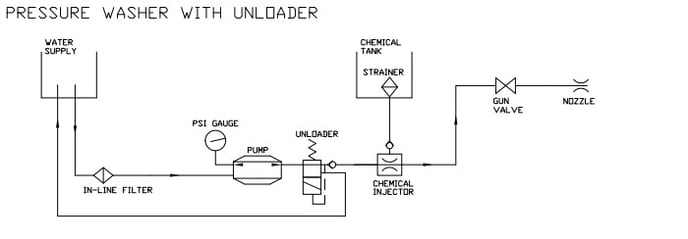Find the basic make up, common issues, and best practices for constructing a pressure washer with an unloader.

Shown above is a general pressure washer system fitted with an unloader. In the diagram you can see the pump pulls water from a supply tank through a filter and sends the water to a pressure gauge to monitor the PSI on one outlet and the other outlet goes to an unloader, after which chemical can be injected into the line and out a gun nozzle. A by-pass line also runs from the unloader back to the original supply tank.
Firstly, the pump you use matters. To reach the desired pressures and flows your system needs, and also considering voltage and amps, please visit this page to view Pumptec's options based off of your needs. Second, the pump needs enough water. Do not run the pump dry, make sure your hoses are properly sized, and all connection points are water tight. We typically recommend using 1/2" S-hose to feed pump inlets, Pumptec pulse hose for pressurized outlets/sections of the system, and 3/8" to 1/2" S-hose on by-pass lines. These hoses keep great shape and allow enough flow. Starving the pump will lead to cavitation. These hoses easily connect with the needed strainers and filters between tank and pump. In some instances, it would be appropriate to pressure-feed the system using city water sources.
Once the fluid leaves the pump, it is imperative to use a dampening hose. At Pumptec, 3/8" pulse hose is widely used. Because of the high operating pressure and the nature of our plunger pumps, the outlet hose type is extremely important to functionality. Be sure to always double check that your inlet and outlet hoses do not get pinched or damaged so as not to overpressure or run dry. Do not run your by-pass line from the regulator directly back to the pump as this could contribute to cavitation and overheating. Run it back to the solution tank as shown in the diagram above. Over-pressuring can also result from the incorrect regulator pressure limit. Pay attention to your gauge, so you do not over-amp your motor or over-pressurize your pump.
For pressure cleaning, the optimal combination of PSI and GPM is a ratio of 1 GPM for every 300-400 PSI. This combination maintains sufficient droplet size for cleaning force and distance. If pressure increases, and flow does not, then the water droplet size reduces and has less impact force, requiring closer cleaning distances and increased risk of surface damage.
To reiterate, avoid starving or running the pump dry, pinched lines, incorrect pressure limits or pressure spikes, overworking the motor and/or pump, and overheating your water, pump and/or motor. Avoiding negative head pressure is also preferrable - this means that the supply tank the pump is drawing from is placed above the pump. One last thing to look for is a dysfunctional nozzle - they may be damaged, worn out, or clogged.
Normal check ups and maintenance checks are recommended on all pumps, hoses, fittings, and nozzles. Below are a few helpful links on pump maintenance, carpet extractors and the pumps on our website.
Helpful Links:
Understanding Pump Flow Rate vs. Pressure and Why it Matters
Soft Wash vs. Pressure Wash: Choosing the Right Method and Pump